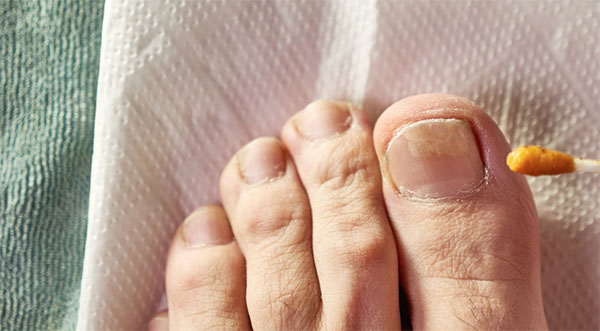Changes That Signal Your Toenail Fungus Is Dying
By Space Coast Daily // November 15, 2023

Toenail fungus, known medically as onychomycosis, manifests in several unappealing ways—yellowing, thickening, and distortion of the nails. This pervasive condition extends far beyond cosmetic inconvenience; it presents a substantial concern to numerous individuals worldwide.
Despite the resilient nature of fungal infections, they are not invincible.
For those wondering how to know if toenail fungus is dying, there’s a constellation of signs that herald the good news.
There exists a series of subtle yet definitive alterations that signal the fungal invasion is in retreat. These modifications in the nail’s appearance serve as a beacon of hope, illuminating the path to recovery. For those seeking understanding and reassurance, recognizing these symptoms can confirm that the tide is turning in the battle against toenail fungus.

Understanding Toenail Fungus
Firstly, one of the earliest signs that your toenail fungus is waving its surrender is a shift in color. Infected nails often present with a yellow, brown, or even black hue. As the fungus begins to lose its grip, you may notice your nail slowly reclaiming its natural, healthy color starting at the cuticle.
Secondly, the texture of your nail can reveal a lot about the state of the infection. Fungus-stricken nails often become thick and crumbly, a stark contrast to the smooth, consistent thickness of a healthy nail. If you observe a new growth that’s closer to normal in texture, it’s a strong indication that the fungus is receding.
Another welcome sign is the reduction in debris under the nails. Fungal infections can cause a buildup of keratinous debris, resulting in separation of the nail from the nail bed. A decrease in this buildup is a clear signal that the end is near for the unwelcome fungus.
Lastly, any improvement in the surrounding skin and nail bed is a positive marker. The skin may have been itchy, cracked, or red around an infected nail. Healing in the skin is often synchronous with the retreat of nail fungus.
Preventative Measures and Lifestyle Adjustments
Ensuring that toenail fungus does not make an unwelcome return is just as crucial as observing its departure. Vigilance in foot care and modifications to daily habits can form an impenetrable defense against reinfection.
To start, it’s essential to keep the feet as dry and clean as possible. Moisture is the playground of fungi, and by denying them this, you significantly reduce their chances to thrive. Choosing the right footwear is another key element in the preventive strategy. Shoes that promote air circulation and are made of breathable materials help in keeping the feet dry and reduce the risk of fungal growth. Similarly, socks should be made of fabrics that wick away moisture from the skin.
When it comes to communal areas such as pools, locker rooms, and showers, exercising caution is paramount. These moist environments are hotspots for fungal transmission. Wearing water shoes or flip-flops can provide a protective barrier between your feet and the fungus-laden surfaces.
Nail care, too, deserves a spotlight in the fight against fungus. Nails should be clipped straight across and kept short, as long nails can trap dirt and debris, offering a sanctuary for fungi.
Moreover, cleanliness of your nail-cutting instruments is just as important; they should be sanitized regularly to prevent the spread of fungus. Implementing thorough foot hygiene rituals is another cornerstone of prevention. This includes washing your feet with soap and water daily, making sure to dry them thoroughly, especially between the toes.
For those particularly susceptible to infections, applying antifungal powders or sprays can serve as an additional preventative measure. In addition to these external measures, bolstering one’s immune system through a balanced diet and regular exercise can also enhance the body’s natural defense mechanisms against toenail fungus. Keeping in check conditions like diabetes that increase the risk of fungal infections is also advisable.
Combating Toenail Fungus
Treatment options for toenail fungus are diverse, ranging from topical solutions and oral medications to laser therapy. But alongside these treatments, some turn to natural supplements to support their fight against fungal infections.
In the journey to reclaim toenail health Fungus Eliminator by Pure Health Research takes place as a formidable support to your overall health. Formulated with natural ingredients like turmeric, bioperine, and a proprietary blend of potent antifungal agents, this supplement is designed to support the body’s natural ability to fight off fungal infections from the inside out. Users are instructed to take two capsules daily, which can potentially aid in boosting the immune system—your body’s first line of defense against pathogens like nail fungus.
While supplements like Fungus Eliminator can be part of a comprehensive approach to treating toenail fungus, it’s crucial to consult with a healthcare provider to tailor a regimen that’s best suited for your specific condition.

In Conclusion
Patience is vital when dealing with toenail fungus. Nails grow slowly, and it takes time for the new, uninfected nail to replace the old, infected one. Consistency in following the treatment regimen prescribed by your healthcare provider, and possibly incorporating supplements.
For those battling toenail fungus, witnessing the infection’s decline can be a slow but immensely satisfying process. Knowing how to recognize the signs of dying toenail fungus is empowering and can bring a sense of control to what may have felt like a relentless condition.
Remember, the journey to recovery starts with understanding the enemy and then watching closely as it begins to wave its white flag of surrender.












